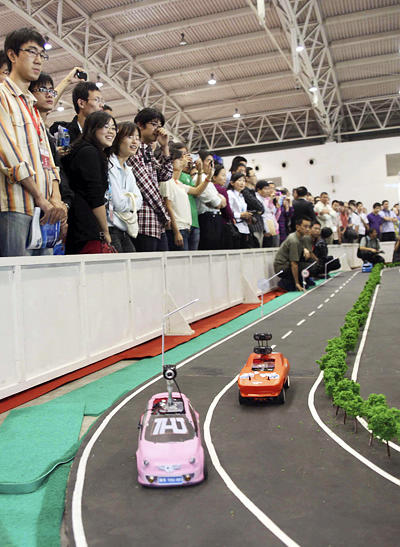|
 |
|
SMALL BUT SMART: Miniature intelligent cars provide an eye opener for visitors to the China International Intelligent Industries Expo in Beijing on September 16 (XINHUA) |
Driverless vehicles may seem like an outlandish concept to most people, more like something from the movie Transformers than everyday reality. The reality in China, however, is that intelligent vehicles have now developed from a concept to a promising area of scientific research.
The intelligent automobile, also known as robotic or driverless, is an autonomous vehicle capable of fulfilling the transportation functions of a traditional car. A human may choose a destination, but is not required to operate the vehicle.
From October 20-21, the residents of Erdos in Inner Mongolia got a glimpse of the future when a number of driverless vehicles drove through the region as part of the China Intelligent Automobile Challenge. Teams from more than 10 universities and research institutes specialized in the research and development of intelligent automobiles, such as Wuhan University and Xi'an Jiaotong University participated in the event.
Hosted by the National Natural Science Foundation Commission of China (NSFC), this is the third installment of the annual competition. The previous two challenges were held in Xi'an, Shaanxi Province.
"This competition offers a platform for us to demonstrate the latest intelligent automobile technologies, turning research fruits from laboratories into real application," said Zheng Nanning, an academician at the Chinese Academy of Engineering and President of Xi'an Jiaotong University.
The 2011 challenge marked the first time the event was held under real road conditions. The intelligent vehicles were separated into groups of two and competed in seven tests which included identifying traffic signs, avoiding barriers and making a U-turn.
Driverless vehicles have been a dream for many scientists and science fiction writers since the automobile was invented. Countries such as the United States and Germany began researching driverless technologies in the 1980s and China is now trying to catch up.
"China's technologies in the field remain underdeveloped, but with more investments and concerted research efforts, huge progress in unmanned vehicles is expected to be made by 2015 and it's very likely that China will soon catch up with the world's leaders in the field," said Zheng.
The goal was set already—by 2015, China should have the technologies for completely automatic unmanned vehicles, which can operate continuously for more than 200 km in a natural environment, and 2,000 km on the expressway.
Defining "smart"
Dubbed "Outdoor Mobile Robots," driverless automobiles see and respond to the world like human beings. The cameras and sensors in the intelligent automobile are like its eyes while the computer is its brain. Information is collected by the "eyes" and integrated and dealt with by the "brain." By processing information on the vehicle's destination, weather conditions and the movement of other vehicles, the electronic "brain" can make quick decisions on the best route and speed.
Intelligent automobile technology integrates advanced technologies in fields such as cognitive science, computer science and artificial intelligence. Perception of the natural environment and intelligent decision making are two key technologies required for unmanned driving.
The National University of Defense Technology successfully ran its unmanned Hongqi HQ3 automobile for more than 286 km, setting a new record in the country on July 14, 2011.
"Human intervention is less than 1 percent of the total, a percentage smaller than the generally defined standard of 3 percent for autonomy, making China one of the countries with world class intelligent automobile technologies," said Dai Bin, one of the scientists working on the experiment.
| 